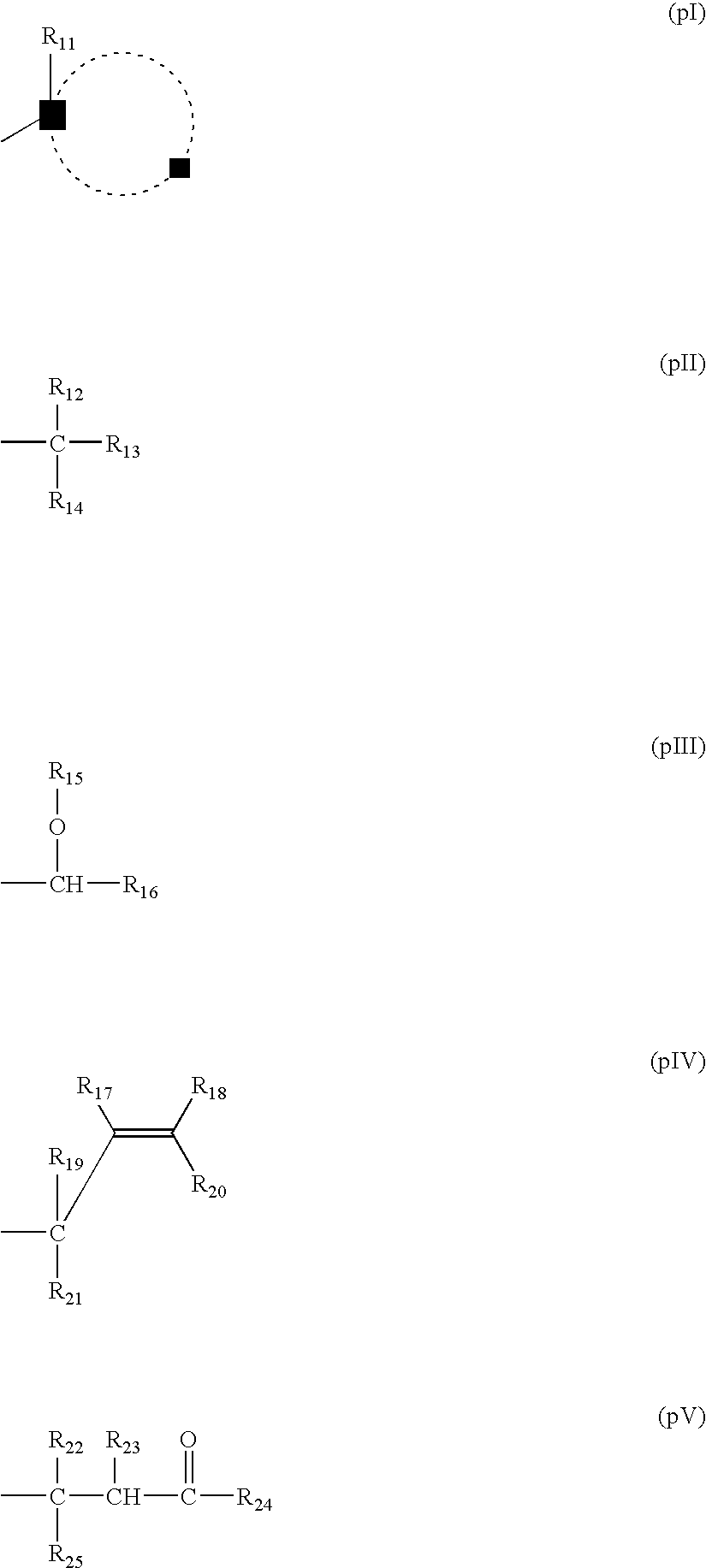Photosensitive composition and pattern forming method using the same
a composition and pattern technology, applied in the field of photosensitive composition and pattern forming method using the same, can solve the problems of high hydrophobic system, difficult development of resist developer with tetramethylammonium hydroxide (hereinafter referred to as tmah) aqueous solution that has been widely used as resist developer, and poor photosensitivity. , to achieve the effect of good resistance development, good photosensitivity, and wide exposure margin
- Summary
- Abstract
- Description
- Claims
- Application Information
AI Technical Summary
Benefits of technology
Problems solved by technology
Method used
Image
Examples
synthesis example 1
Synthesis of Resin (1) (Side Chain Type)
[0632] 2-Ethyl-2-adamantyl methacrylate and butyrolactone methacrylate were charged in a proportion of 55 / 45 and dissolved in methyl ethyl ketone / tetrahydrofuran (5 / 5) to prepare 100 mL of a solution having a concentration of solids of 20%. To this solution, 2% by mole of V-65, manufactured by Wako Pure Chemical Industries, Ltd. was added, and the mixture was dropped in 10 mL of methyl ethyl ketone heated at 60° C. over 4 hours in a nitrogen atmosphere. After completion of dropping, the reaction solution was heated for 4 hours, 1% by mole of V-65 was again added, and the mixture was stirred for 4 hours. After completion of the reaction, the reaction solution was cooled to room temperature and crystallized from 3 L of a mixed solvent of distilled water / isopropyl alcohol (1 / 1), thereby recovering a resin (1) as a deposited white powder.
[0633] The polymer formulation ratio determined by C13—NMR was 46 / 54. Also, the weight average molecular weig...
synthesis example 2
Synthesis of Resin (13) (Principal Chain Type)
[0635] t-Butyl norbornenecarboxylate, butyrolactone norbornenecarboxylate and maleic anhydride (molar ratio: 40 / 10 / 50) and THF (reaction concentration: 60% by weight) were charged in a separable flask, and the mixture was heated at 60° C. under a nitrogen gas stream. When the reaction temperature became stable, 2% by mole of a radical initiator V-601, manufactured by Wako Pure Chemical Industries, Ltd. was added to initiate reaction. The mixture was heated for 12 hours. The resulting reaction mixture was diluted two times with tetrahydrofuran and then thrown into a mixed solution of hexane / isopropyl alcohol (1 / 1) to deposit a white powder. The deposited powder was taken out by filtration and dried to obtain a desired resin (13).
[0636] The resulting resin (13) was subjected to molecular weight analysis by GPC and found to be 8,300 (weight average) as reduced into polystyrene. Also, according to the NMR spectrum, the resin (13) was confi...
synthesis example 3
Synthesis of Resin (20) (Hybrid Type)
[0638] Norbornene, maleic anhydride, t-butyl acrylate, and 2-methylcyclohexyl-2-propyl acrylate were charged in a molar ratio of 35 / 35 / 20 / 10 in a reactor, and the mixture was dissolved in tetrahydrofuran to prepare a solution having a content of solids of 60%. This solution was heated at 65° C. under a nitrogen gas stream. When the reaction temperature became stable, 1% by mole of a radical initiator V-601, manufactured by Wako Pure Chemical Industries, Ltd. was added to initiate reaction. After heating for 8 hours, the reaction mixture was diluted two times with tetrahydrofuran, and the reaction mixed solution was thrown into a five-time volume of hexane to deposit a white powder. The deposited powder was taken out by filtration, dissolved in methyl ethyl ketone, and re-precipitated in a five-time volume of a hexane / t-butyl methyl ether (1 / 1) solution. A deposited white powder was collected by filtration and dried to obtain a desired resin (20)...
PUM
| Property | Measurement | Unit |
|---|---|---|
| Solubility (mass) | aaaaa | aaaaa |
| Molecular weight | aaaaa | aaaaa |
| Photosensitivity | aaaaa | aaaaa |
Abstract
Description
Claims
Application Information
 Login to View More
Login to View More - R&D
- Intellectual Property
- Life Sciences
- Materials
- Tech Scout
- Unparalleled Data Quality
- Higher Quality Content
- 60% Fewer Hallucinations
Browse by: Latest US Patents, China's latest patents, Technical Efficacy Thesaurus, Application Domain, Technology Topic, Popular Technical Reports.
© 2025 PatSnap. All rights reserved.Legal|Privacy policy|Modern Slavery Act Transparency Statement|Sitemap|About US| Contact US: help@patsnap.com



